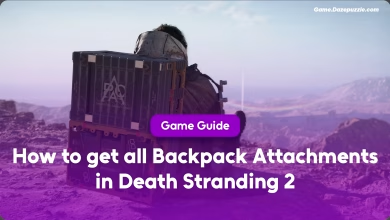Alright, comrade! You’ve landed in the right place if you’re looking to survive the bureaucratic nightmare that is the Arstotzkan border in “Papers, Please.” This ain’t your typical run-and-gun, but trust me, the tension of deciding who gets in and who gets the dreaded “Denied” stamp is surprisingly addictive. So, grab your rulebook (both the in-game one and this guide!), and let’s dive into some crucial tips and tricks to make your life as Inspector a little less… well, Arstotzkan.
Welcome to Grestin, Inspector! Time to Get Your Stamp On
Okay, so you’ve probably figured out the gig by now. People lining up, you in your little booth, and a whole lotta paperwork standing between order and chaos (or maybe just some dude trying to sneak in with a fake passport). “Papers, Please” throws you into this intense role, and it can feel overwhelming at first. You’re not just checking IDs; you’re making decisions that impact lives, your family’s well-being, and even the fate of Arstotzka itself.
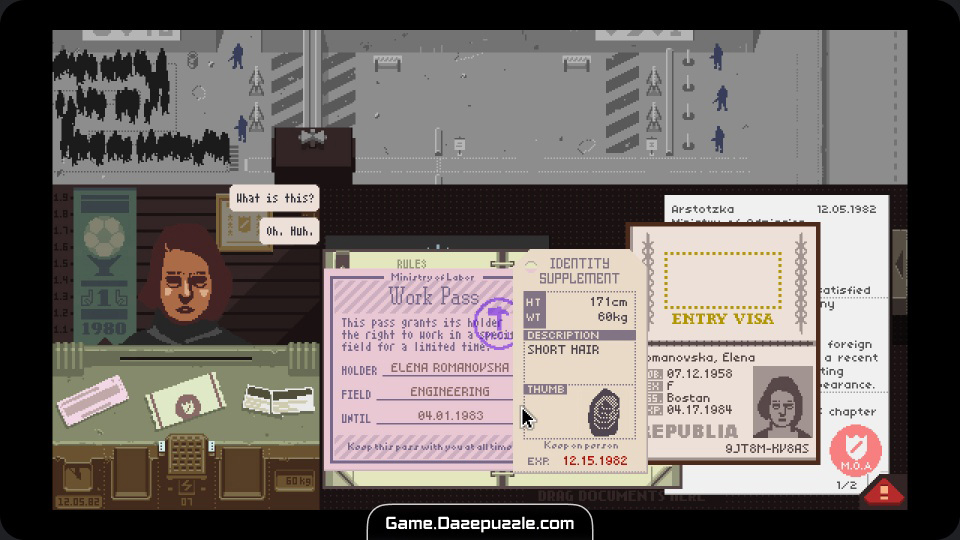
This guide is your trusty companion, your digital comrade, here to arm you with the knowledge you need to not just survive, but maybe even thrive (in a bleak, totalitarian sort of way). Whether you’re fresh off the boat (figuratively speaking, of course) or you’ve already seen your fair share of forged documents, there’s something in here for you. We’ll break down the basics, get into the nitty-gritty of spotting fakes, and even touch on how to keep your virtual family fed and warm. So, let’s get started, Inspector! Glory to Arstotzka! (or maybe not, we’ll see how things go).
The Inspector’s Toolkit: Your Rulebook and Eagle Eyes
Alright, first things first, let’s talk about your bread and butter: the rulebook. Seriously, this little digital pamphlet is your best friend in this game. Forget about fancy gadgets for now; your ability to read and understand those daily directives is what separates the rookies from the seasoned border guards.
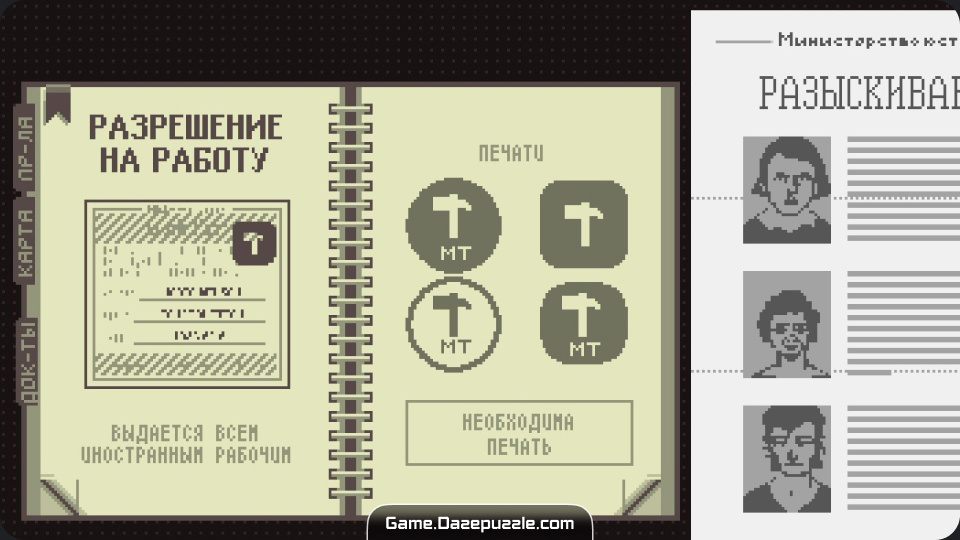
The Sacred Texts: Mastering the Rulebook
Seriously, treat that rulebook like it’s the last piece of Cobrastanian chocolate on Earth. Before you even think about stamping your first document each day, crack it open and devour every word. New rules pop up constantly, and missing even a small change can lead to penalties that’ll make your already meager salary look even sadder. Pay attention to everything – new required documents, changes to existing rules, even specific details about allowed nationalities or entry purposes. Get familiar with how to navigate it quickly; time is money (literally!), and fumbling through pages will cost you.
Document Dive: Getting Down to Inspection Basics
Okay, rulebook digested? Good. Now, let’s talk about the actual inspection process. You’ve got a few key moves in your arsenal. You can compare documents side-by-side, zoom in with your magnifying glass (essential for those tiny details!), and later on, you’ll get fancy tools like fingerprint scanners.
The core of your job is simple: does the information on all the presented documents match up with the current rules and with each other? Name, date of birth, expiry dates – these are your go-to fields. Get into the habit of checking them first. Is the name spelled the same on the passport and the entry permit? Does the birthdate make sense? Is the passport still valid? These seem obvious, but trust me, under pressure, it’s easy to miss these simple checks.
Clock’s Ticking: Efficiency is Key (Eventually)
Each day, you’ve got a limited amount of time to process applicants. The faster you are (without making mistakes!), the more you earn. In the beginning, focus on accuracy. Penalties for letting the wrong people through or denying legitimate applicants will eat into your earnings faster than you can say “Cause trouble on Arstotzkan soil.” However, as you get more comfortable with the rules and the flow of things, you’ll naturally start to speed up. Develop a routine. Maybe you always check the photo first, then the name, then the expiry date. Find a system that works for you and stick to it.
Your Booth, Your Rules (Sort Of): Navigating the Interface
Your little inspector booth is your domain. Get to know its quirks. The speaker lets you hear the applicant, the intercom allows you to ask questions, and that big red button? That’s your friend (or enemy) – the detention button. Learn when to use each of these effectively. Don’t be afraid to use the intercom to clarify something if you’re unsure. A quick question can save you from making a costly mistake. But be warned, some applicants aren’t exactly forthcoming with the truth.
Spotting the Sneaky Ones: Identifying Inconsistencies and Forgeries
This is where the real fun (and frustration) begins. Not everyone lining up is on the up-and-up. Some folks are trying to sneak in with forged documents or misleading information. Your job is to be the ultimate gatekeeper, spotting those red flags before they slip through.
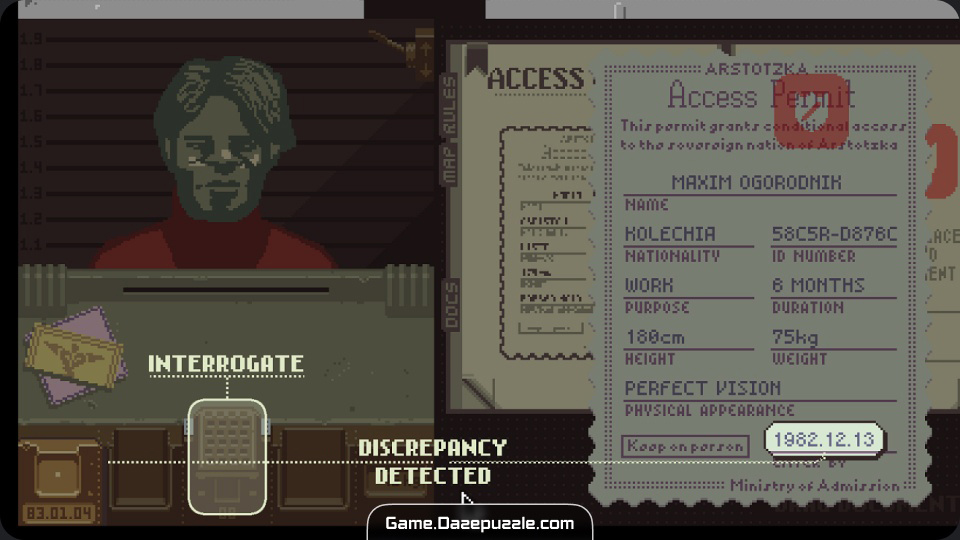
Name Games: When Aliases Aren’t Just for Spies
Keep a close eye on names. Sometimes it’s a simple typo, but other times, it’s a deliberate attempt to deceive. Check if the name on the passport matches the name on the entry permit, work permit, or any other documents they present. Pay attention to subtle differences in spelling or the use of initials.
Time Travelers? Date and Time Anomalies
Dates are another prime area for inconsistencies. Always check the birth date, issue date, and expiry date on all documents. Does the expiry date fall before the current date? Is the issue date in the future? These are immediate red flags. Also, be mindful of the overall timeline. If someone claims they’re visiting for a week but their entry permit expires in two days, something’s fishy.
Picture This: Spotting the Wrong Faces
The photograph on the passport should always be your first visual check. Compare it carefully to the person standing in front of you. Look for obvious differences in facial features, hair color, or even age. Sometimes the forgeries are laughably bad, but other times they’re more subtle. Don’t be afraid to take your time and really scrutinize the picture.
Stamp of Approval (or Disapproval): Missing or Fake Seals
Official stamps and seals are crucial for verifying the authenticity of documents. As the game progresses, you’ll learn to recognize the legitimate stamps of Arstotzka and other countries. Be on the lookout for missing stamps, blurry or poorly printed stamps, or stamps that just don’t look quite right. The rulebook will often provide examples of valid stamps, so refer to it!
Number Crunch: When Digits Don’t Add Up
Document numbers should also be consistent across different forms. Check if the passport number on the passport matches the one listed on the entry permit. Be wary of numbers that look like they’ve been altered or don’t follow the expected format (which you’ll learn over time).
You might also like this: Assassin’s Creed Shadows Review
Height and Weight: The Less Obvious Clues
Sometimes, discrepancies can be found in the less obvious details, like height and weight listed on the passport. While these can have natural variations, significant differences might indicate a problem.
Story Time: When Their Words Don’t Match Their Papers
Pay attention to what the applicant tells you. Does their stated purpose of visit align with the type of entry permit they’re presenting? If someone says they’re coming for a week-long vacation but has a work permit, that’s a major red flag. Don’t be afraid to ask clarifying questions using the intercom if something doesn’t add up.
Level Up Your Inspection Game: Advanced Techniques
Once you’ve got the basics down, it’s time to delve into some more advanced techniques to become a true master of the border.

The Power of Cross-Referencing: Connecting the Dots
Never look at just one document in isolation. Always compare the information across all the documents an applicant presents. A seemingly minor inconsistency on one form might be a crucial piece of the puzzle when viewed alongside another.
The Devil’s in the Details: Paying Attention to the Small Stuff
Become a detail-oriented inspector. Look for subtle clues like smudged ink, misaligned text, different paper quality, or signs of tampering on the documents. These small details can often be the telltale signs of a forgery.
Trust Your Gut (But Verify!): When Intuition Strikes
Sometimes, you’ll just get a bad feeling about someone. While you should always base your decisions on the rules and the documents, don’t completely ignore your intuition. If something feels off, take a closer look. However, always try to find concrete evidence before denying entry or detaining someone. You don’t want to penalize innocent people based solely on a hunch.
Adapting to Change: Mastering New Rules and Tools
“Papers, Please” constantly throws new rules and tools your way. As the days progress, you’ll get access to things like fingerprint scanners and more complex regulations. Make sure you understand how to use these new tools effectively and always pay close attention to any new directives in the rulebook.
Keeping Your Family Alive (Virtually): Managing Finances and Family
It’s not just about the border; you’ve got a family to take care of! Your daily salary, based on how many people you process correctly, is crucial for their survival.
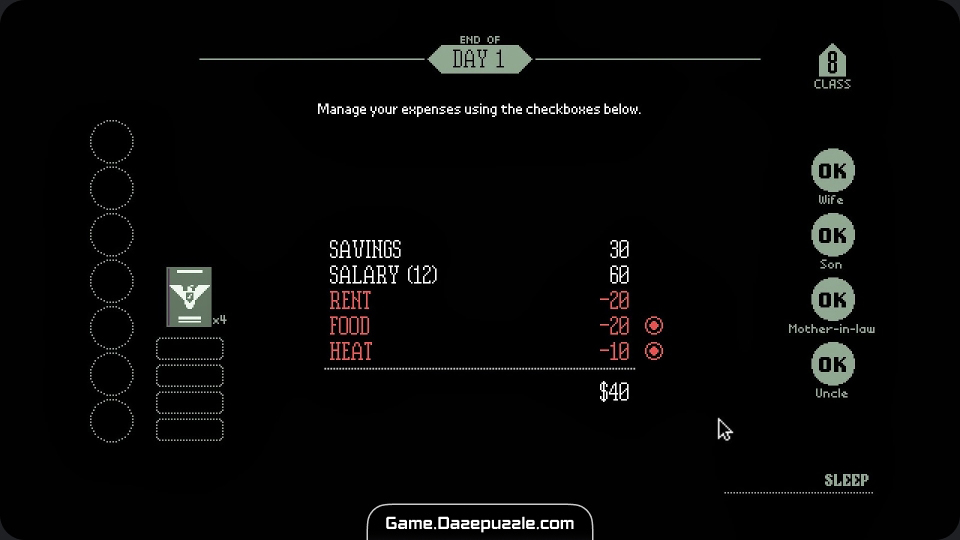
Counting Your Pennies: Understanding Salary and Expenses
You earn a small amount for each correctly processed applicant. However, mistakes will cost you. At the end of each day, you’ll have to pay for rent, food, and potentially heating and medicine for your family. Knowing how much you earn and how much you need to spend is vital for making ends meet.
Family First (Mostly): Prioritizing Their Needs
You’ll often face tough choices between earning more by rushing through inspections and ensuring your family has enough food and heat. Try to strike a balance. While you need to be efficient, don’t let your family suffer too much in your pursuit of a perfect inspection record.
Smart Spending: Making Your Rubles Count
Be mindful of how you spend your hard-earned rubles. Sometimes you’ll have the option to buy upgrades or extra supplies. Consider carefully whether these purchases are worth the cost and how they will impact your family’s well-being.
Morality Bites: The Impact of Your Choices
Your decisions at the border can have far-reaching consequences, not just for the people trying to enter Arstotzka, but also for your family and the overall narrative of the game. Sometimes, you’ll be faced with moral dilemmas. Think carefully about the potential outcomes of your choices.
Playing the Political Game: Dealing with Organizations
As the story unfolds, various organizations will approach you with requests. These side missions can offer rewards, but they also come with risks.

Friends in Low Places: Understanding the Factions
You’ll encounter different factions with their own agendas. These might include resistance groups, government agents, or even smugglers.
Risk vs. Reward: Weighing Your Options
Helping these organizations can provide you with extra money or other benefits, but it can also put you in danger or have negative consequences down the line. Carefully consider the potential risks and rewards before agreeing to any requests.
Follow the Leader (Carefully): Executing Instructions
If you decide to help an organization, make sure you understand their instructions perfectly and execute them precisely. Failing to do so could have serious repercussions.
Your Choices Matter: Shaping the Narrative
Your interactions with these organizations will play a significant role in shaping the story and ultimately determining which ending you get.
Specific Document Deep Dive: Nailing Each Type
Let’s break down some of the common document types you’ll encounter and some specific things to look out for.
Passports: The Gatekeepers
Passports are your most common document. Always check the expiry date, the issuing authority, the photograph, and the personal details (name, date of birth, etc.). Pay close attention to the official stamps and seals.
Entry Permits: The Golden Tickets
Entry permits specify the purpose and duration of an applicant’s visit. Make sure the information on the entry permit aligns with the applicant’s stated intentions and that it’s valid for the current day.
Work Permits: Earning a Living in Arstotzka
Work permits will have details about the applicant’s employer and the duration of their employment. Verify that the information is consistent and that the permit is still valid.
Identity Cards: Proof of Citizenship
Identity cards are used by Arstotzkan citizens. Check the photograph and the personal details. You’ll learn to recognize the official format of Arstotzkan IDs.
Other Documents: The Unexpected Paperwork
As the game progresses, you’ll encounter other types of documents, such as vaccination records or transit visas. Always read the rules carefully to understand the requirements for each new document.
Final Thoughts, Comrade: You’ve Got This!
So there you have it, a comprehensive guide to navigating the challenging world of “Papers, Please.” Remember, the key to success is patience, careful observation, and a meticulous attention to detail. Don’t get discouraged by early mistakes; everyone gets tripped up by a sneaky forger now and then. Learn from your errors, adapt to the ever-changing rules, and trust your instincts (but always verify!).
Whether you’re striving for a perfect inspection record, trying to keep your family fed, or aiming to see all the different endings the game has to offer, we hope this guide has given you the knowledge and confidence you need to face the daily grind at the Grestin border. Now go forth, Inspector, and may your stamps be ever accurate! Glory to… well, you know the rest. Good luck out there!
Thanks for keeping up with Game.DazePuzzle.com



